Parents: Alfred Holness (1819–1911) and Mary Ann Holness, born Roberts (1920–1893)
Siblings: Edwin Holness (born 1848), Fanny Holness (born 1851)
Wife: Mary Amelia Say Alloway (1848–1931), daughter of Charles Alloway and Elizabeth Alloway
Children: Alfred Holness (born 1872), Ada Holness (born 1873), Edith Holness (1875–1948), Edwyn Holness (1876–1955)
Source: https://www.geni.com/people/Alfred-Holness/6000000004199642296
Alfred Holness was another well known Brethren (and Christian) publisher. He was born in Kent, in the area south of Canterbury. By 1881, he had moved to East Dulwich in London, and was described in the census as "Publisher & Bookseller Employing 3 Men 1 Woman & 1 Boy".
His business seems to have operated firstly from 21 Paternoster Row in the 1870s, and later from 14 Paternoster Row by at least the early 80s.
He was given the Freedom of the City of London in 1882!
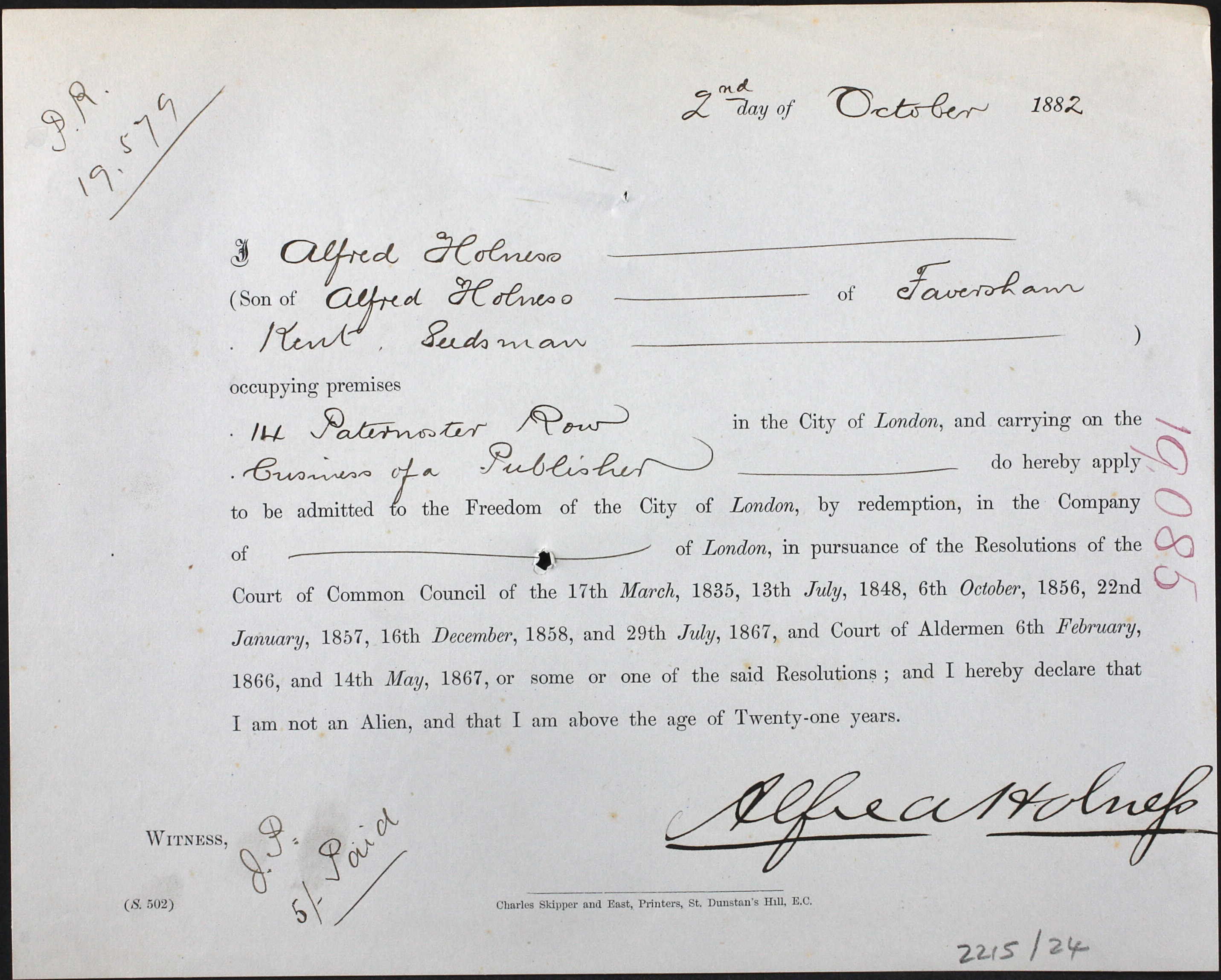
There is an entry in the Booksellers Review, but I can only see the first line which reads "ALFRED HOLNESS. (Paternoster Row, E.C.) Mr. Alfred Holness' handsome show-rooms in the Row are packed once again with a choice assortment of the .. ". From here; https://www.newspapers.com/newspage/35616499/
A picture of his son Edwin, can be seen here.
He died in London, but can not find a record of his grave.
Judging by Kelly's letters, Holness must have sided with Fereday in the 1900 trouble (27 Nov 1900: "Holness too is with the rebels; but even before, what a stagnant pool is his 'Springing Well'?"; 28 Nov 1901: "I have begged S.S. not to supply H.’s Springing Well. It is a stagnant pool; & he is an adversary."). He seems to have had "Open" tendencies for some years before (8 Nov 1893: "I do not know what they feel at Holness publishing! Burridge’s magazine, as well as his advocacy of looseness; but I should shrink from going into partnership ecclesiastically with people who are not decided in shunning such folk and ways.").
I've just seen there is a death notice in the Believer's magazine .. also gives where he was buried.
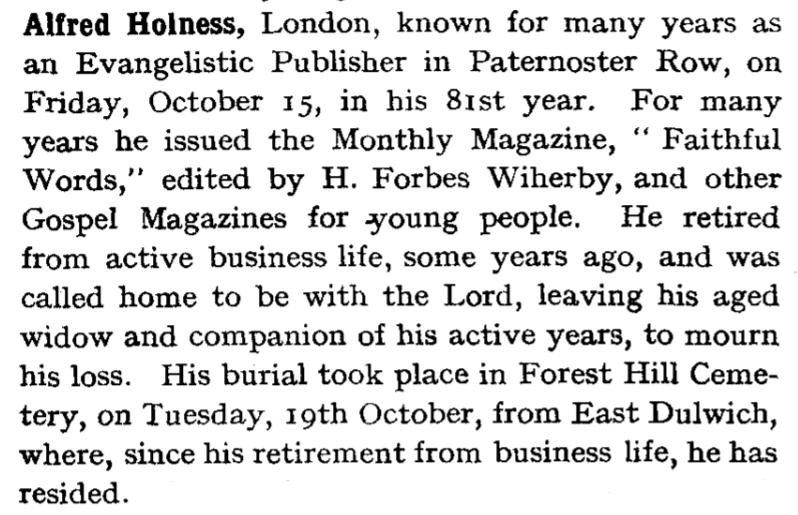
Thanks for the links Martin,
For anyone interested, I've copied the quote from the astronomical society here ..
Alfred Holness was born in 1846 at Faversham, Kent, where his father was a market gardener. Quite early in his life he went up to London and was employed in the firm of Mr. W. H. Broom, a publisher ; of religious works. A few years later he decided to commence on the same lines for himself, and for fifty-three years he was engaged on this work, retiring from the City in 1919. He published during his long business life a large number of evangelical periodicals and pamphlets, and was the editor of The Springing Well. He also took part in evangelical work in lodging-houses, public halls, and theatres. Owing to his numerous occupations, he was unable to do any practical work in astronomy, but he took a lifelong interest in the science, and was a regular attendant at the Society’s meetings. After retiring from business he visited his sons in Canada and South Africa, and whilst in Durban he was delighted at being allowed to observe with the telescope at the Observatory. His outlook on life was a world-wide one, and he was a Fellow of the Royal Geographical Society. He married in 1871, and died on 1926 October 8, leaving a widow, two sons, and two daughters. He was elected a Fellow of the Society on 1918 January 11.
Interesting that he himself started by working for W.H. Broom.
And also the piece about Mrs Holness;
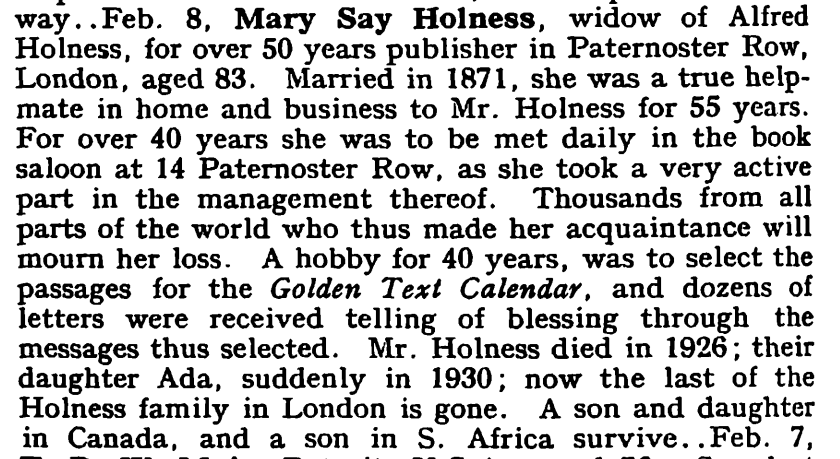
I saw another reference to his former book-shop in that volume as well;
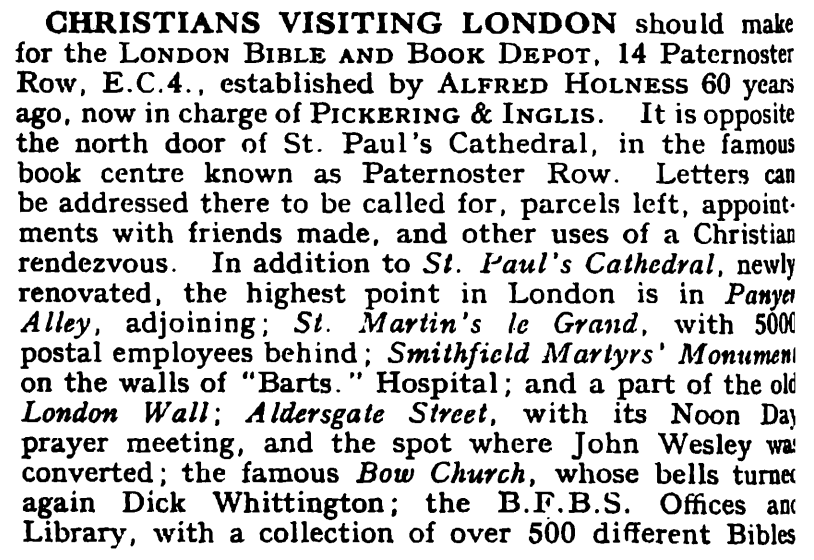
Paternoster Row and the adjoining area must have been an amazing place (before it was destroyed during the Blitz), with pretty much every shop being a bookseller.
Finding pictures of what it once was like was harder than I imagined it would be .. but here are a few for anyone interested;
Firstly, one from an 1835 Print;
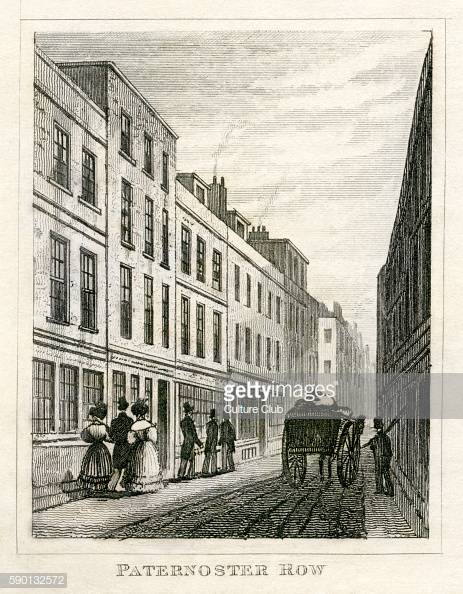
The next from 1851 by Thomas Colman Dibdin
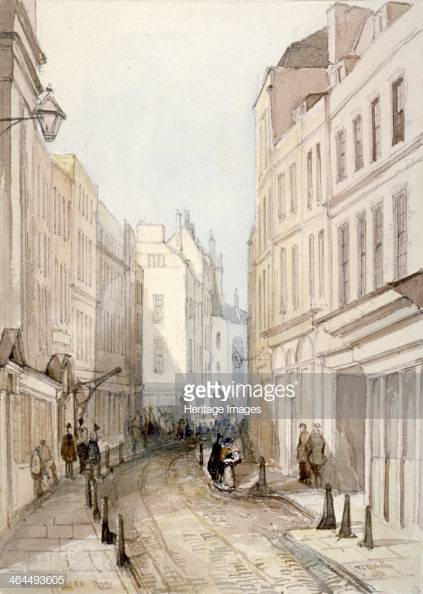
This image is taken from “Pleasant Hours: A Monthly Journal of Home Reading and Sunday Teaching; Volume III” published by the Church of England’s National Society’s Depository, London, in 1863.
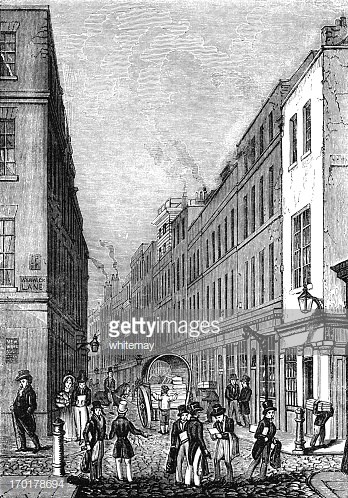
Another picture from the Illustrated London News in the same year showing some new buildings in Paternoster Row. The street seems a lot wider at this end.

Similar looking is the RTS building; this one from around 1848,
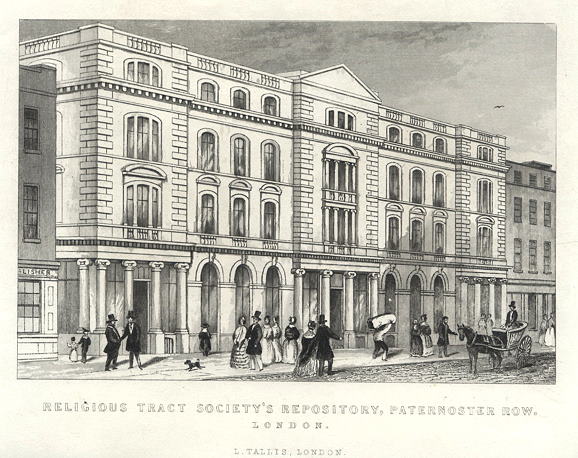
This one showing, St Paul's Cathedral, the west end of Cheapside, Paternoster Row, Newgate Street and Fleet Street, from 'Collins' Illustrated Guide to London and Neighbourhood', 1871.
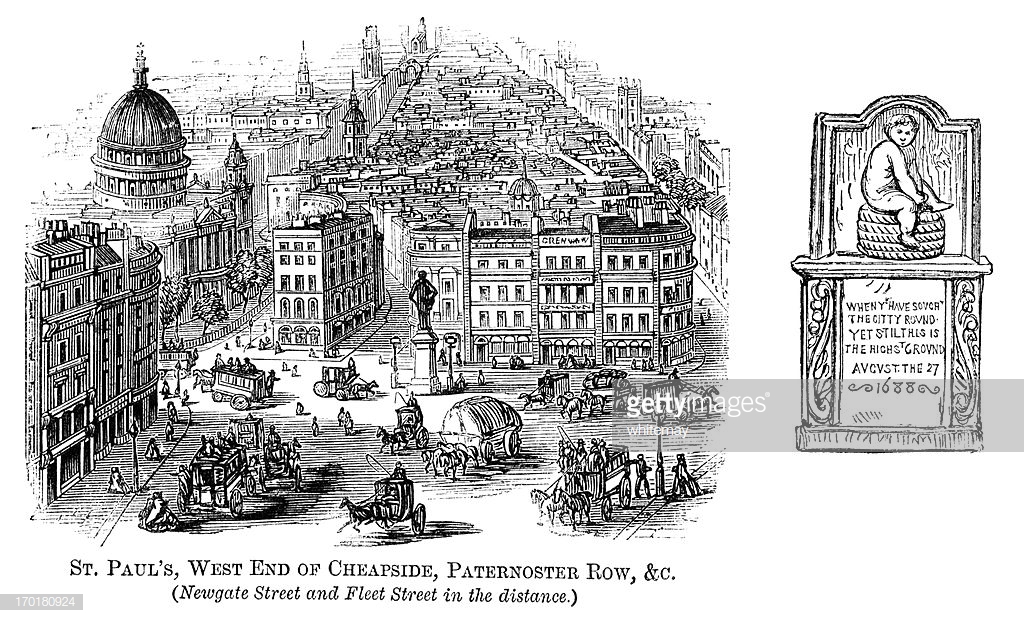
And a later one from 1911, from The City, by Sir Walter Besant.
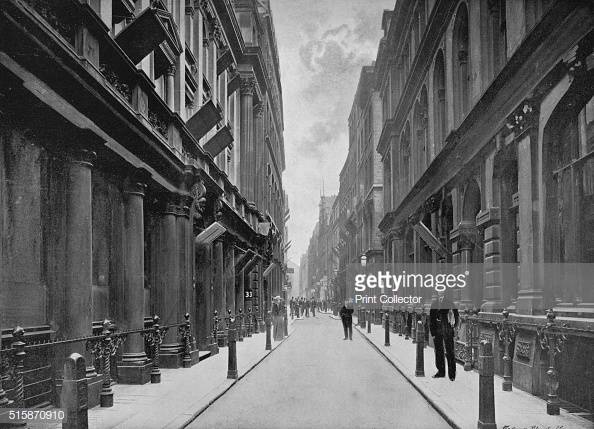
Finally a map of the area from 1868, which also shows Warrick Square to the left - the location of the original Brethren Tract depot in London.
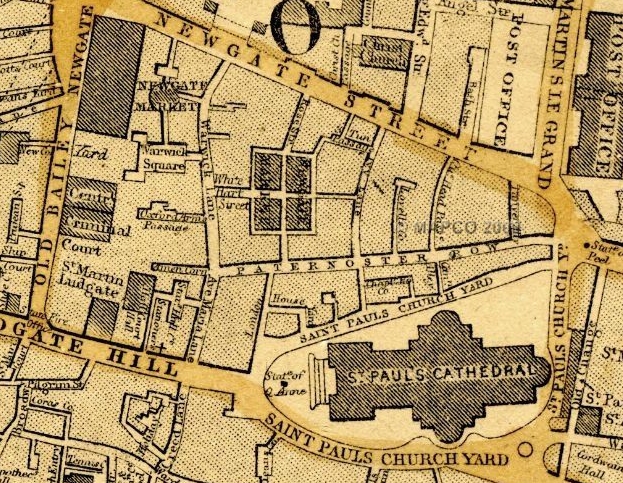
This page is also interesting on the subject; https://abeautifulbook.wordpress.com/2014/02/23/paternoster-row-london/
And the wikipedia page gives the numbers of various booksellers on the street; https://en.wikipedia.org/wiki/Paternoster_Row
An example advertisement, from 1891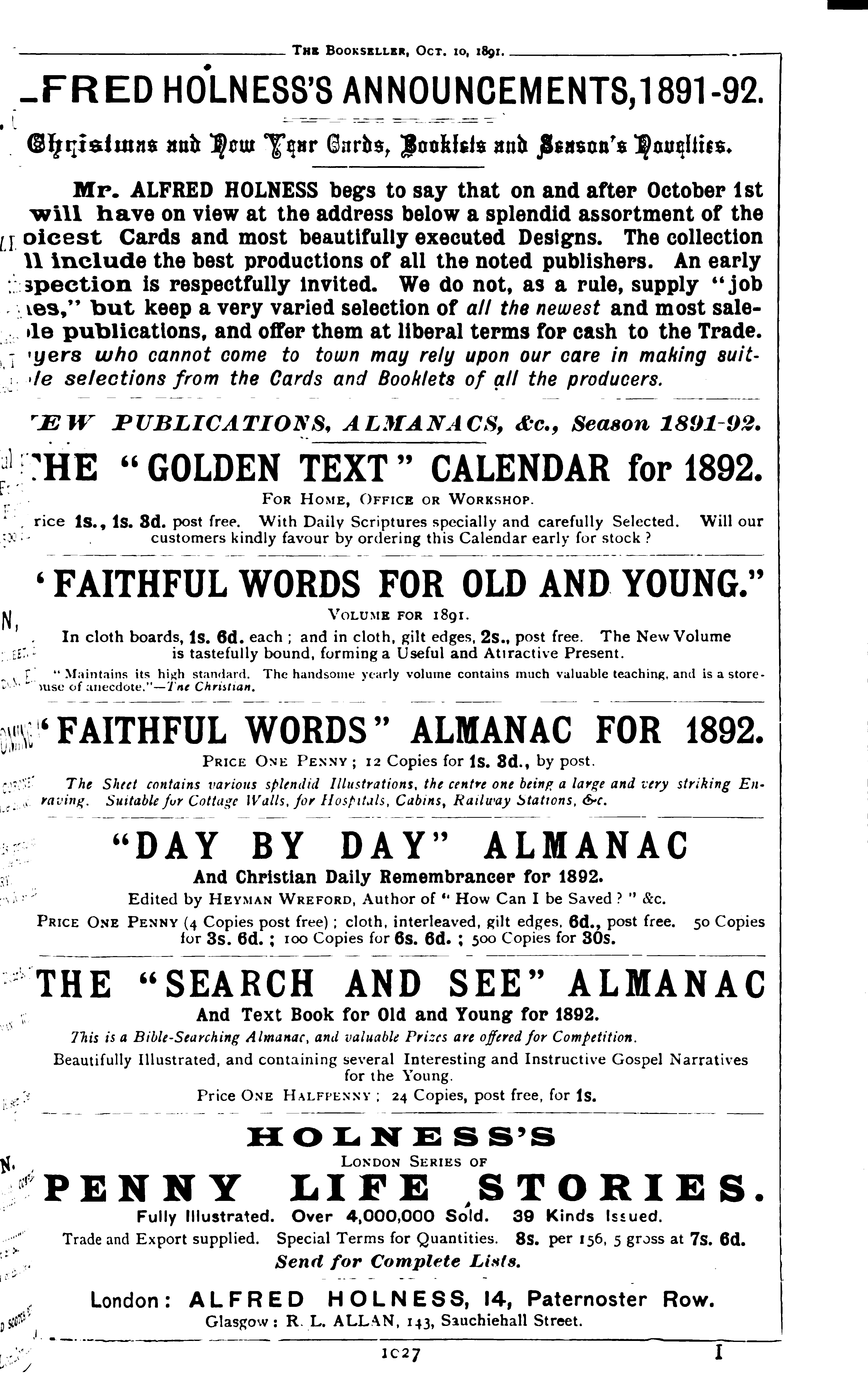
Another one from 1908, this time in "The United Methodist" magazine!
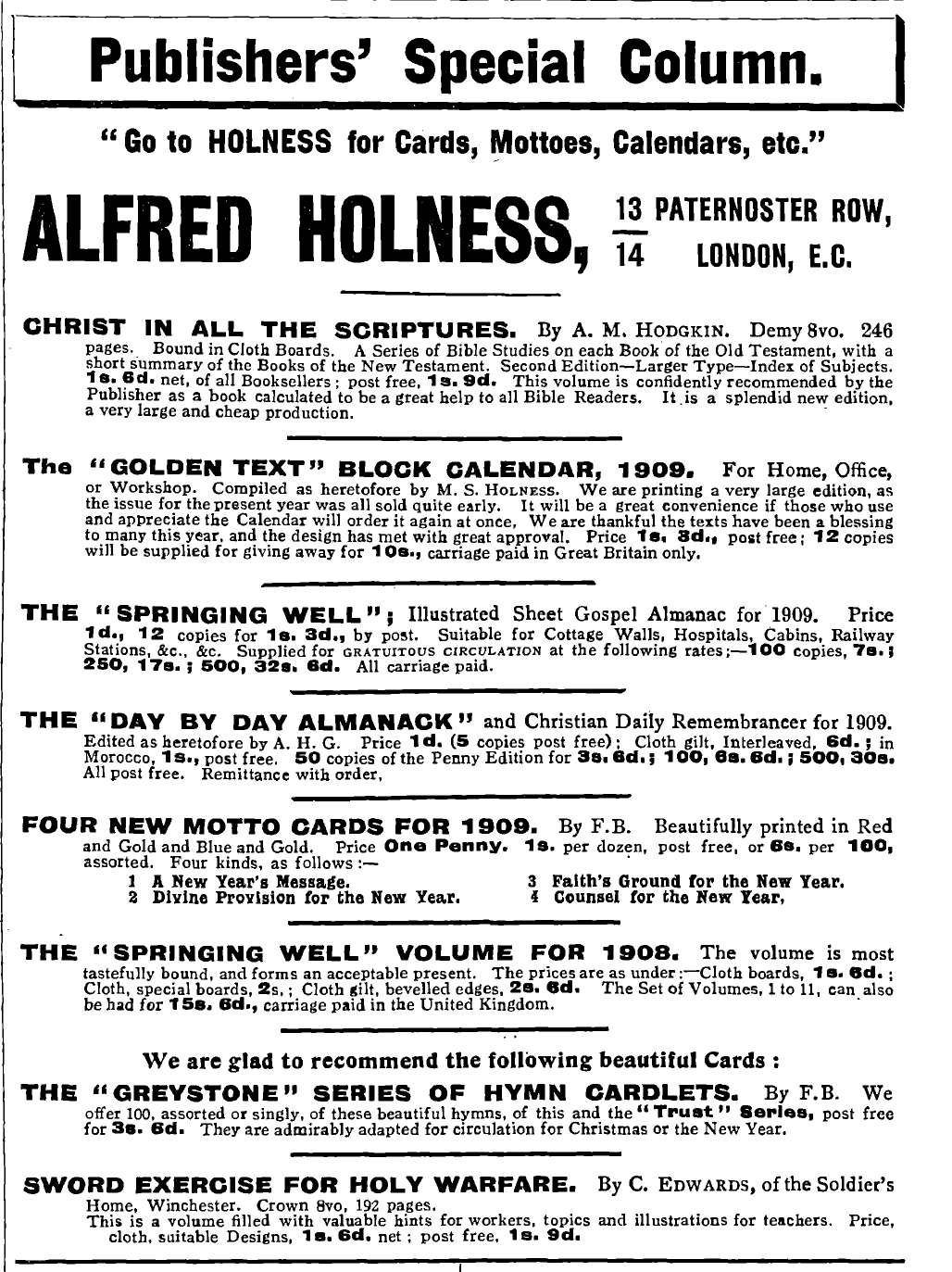
And one more from the same magazine, 1912
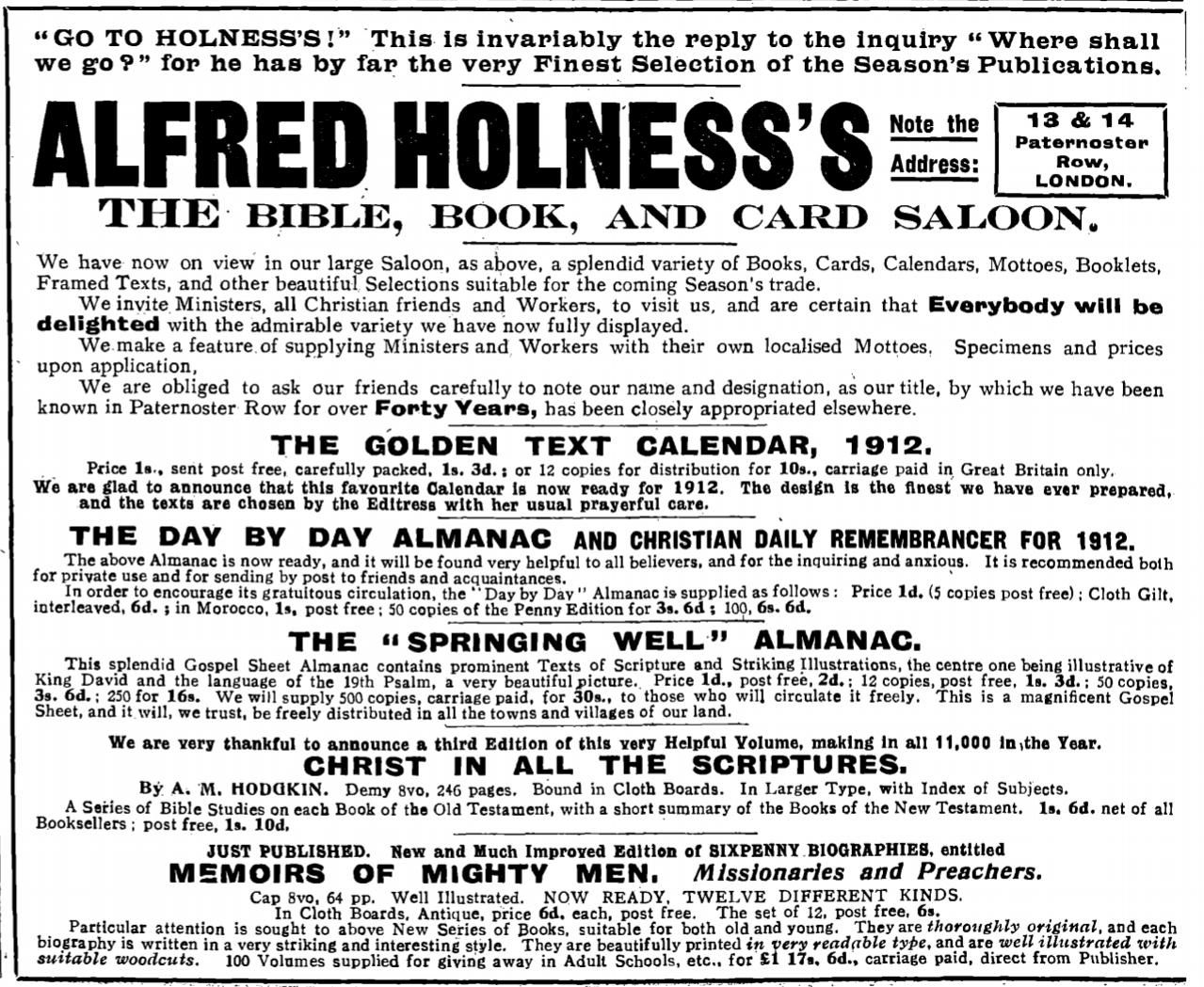
Alfred Holness – 14th May 1845 ~ 8th October 1926.
Birth: Upper Hardres Court, Kent, England.
Marriage: January 1872 at Pancras, London, England.
Death: 1 Friern Road, East Dulwich, London, England.
Burial: Honor Oak Cemetery or Forest Hill Cemetery.
Wife: Mary Amelia Say Alloway – 18th Oct. 1848 ~ 8th Feb. 1931.
Burial: Camberwell Old Cemetery with Miss Ada.
Children:
Alfred (J. Copson) – 2nd April 1872 ~ 3rd Dec. 1947.
Ada – March 1873 ~11th August 1930.
Edith – December 1874 ~
Edwyn (M.W. Whitelaw) – 31st Dec.1876 ~ 16th June 1955.
Father: Alfred Holness – January 1819 ~ January 1911.
Married on 9th May 1843 at Hackington, Kent.
Mother: Mary Ann Roberts – 1818 ~ October 1893.
Siblings:
Mary Ann (A. Hogben) – 1844 ~ January 1911.
Edwin (M.E. Gifford) – Sept. 1849 ~ 4th March 1936.
Fanny (E.H.R. Napier) – March 1851 ~ Sept. 1924.
Suddenly, as the result of a shock, Miss Ada Holness, Dulwich. daughter
of the late Alfred Holness, Publisher, and Mrs. Holness, aged 57.
Known to many as for a number of years, was valuable assistant in the
business at 14 Paternoster Row. Of a kindly disposition, sought to visit
the aged, poor, and needy.
“The Witness” 1930
Hudson Taylor includes that poem in this book he wrote:
https://www.gutenberg.org/cache/epub/26384/pg26384-images.html
Philip Schaff ascribes it to Mrs. KH Johnson:
https://archive.org/details/ALibraryOfReligiousPoetry/page/167/mode/1up?q=twilight
The writer of the poem was Mrs. Catherine Hardenbergh Johnson (1835–1907). I doubt that she was amongst “Brethren” (so called); at least her husband was a Presbyterian ministers in Illinois, see here:
http://www.hymntime.com/tch/bio/j/o/h/n/s/o/johnson_ch.htm
The poem was early printed in some magazines of “Brethren” in North America:
- Sound Words 6 (1875), p. 27 – 28
- Glad Tidings (by Th. Somerville) 7 (1878), p. 84
- The Barley Cake 1 (1881), p. 107 – 108 (author given as “Mrs. Johnson”)
- Tender Grass and Waters of Quietness 1885, p. 189-190 (author given as “Mrs. Herrick Johnson”)
Martin